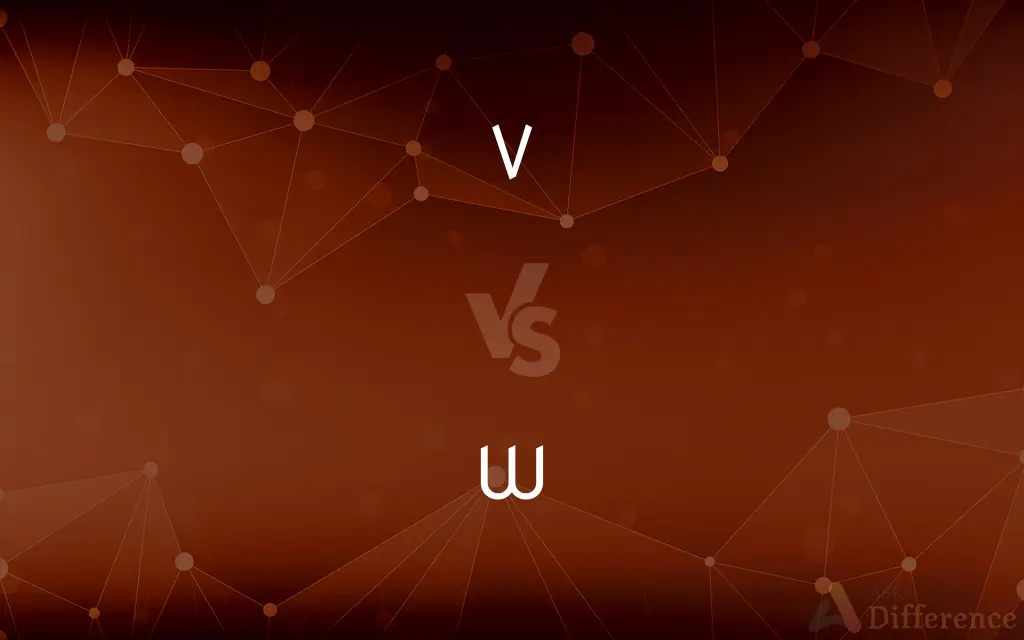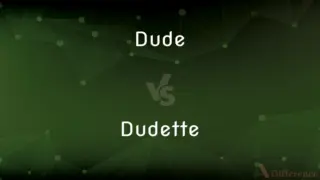V vs. W — What's the Difference?
By Urooj Arif & Fiza Rafique — Updated on March 20, 2024
V is a consonant pronounced with the upper teeth and lower lip, used in words like "victory", while W is a semi-vowel pronounced with both lips, used in "water".

Difference Between V and W
Table of Contents
ADVERTISEMENT
Key Differences
V, represented in the International Phonetic Alphabet (IPA) as [v], is a voiced labiodental fricative, produced by touching the bottom lip to the upper teeth and voicing. This sound is sharp and clear, as found in "vase" or "vivid". On the other hand, W, represented as [w] in the IPA, is a voiced labio-velar approximant, produced by rounding both lips and voicing without creating a turbulent airflow, resulting in a softer and more rounded sound as in "wish" or "wear".
V often marks words of Latin or Romance languages origin, contributing to the vocabulary with terms like "velocity" and "virtual". Whereas W typically signifies words of Germanic origin, enriching the English language with words such as "will" and "wind".
In spelling, V is unambiguous, always representing the same sound. Words like "vote" and "vivid" clearly illustrate its consistent phonetic representation. However, W can represent a variety of sounds in different languages, though in English, it is consistently the [w] sound as in "wave" or "wood".
V does not typically influence the vowel sounds that follow it, maintaining its crisp, clear pronunciation in various contexts. Meanwhile, W often affects the quality of the proceeding vowel, creating diphthongs, as in "cow" or "how", adding a distinctive glide to the vowel sound.
In typography and handwriting, V is depicted with a sharp, pointed shape, whether in uppercase or lowercase. W, conversely, is characterized by its double-U shape, showcasing a more rounded and wider appearance in both its uppercase and lowercase forms.
ADVERTISEMENT
Comparison Chart
Phonetic Category
Voiced labiodental fricative
Voiced labio-velar approximant
Origin of Words
Often Latin or Romance
Often Germanic
Spelling Consistency
Always represents the same sound
Consistently represents the [w] sound in English
Effect on Following Vowels
Does not typically affect following vowels
Often affects the quality of the proceeding vowel
Typography and Handwriting
Sharp, pointed shape
Rounded, double-U shape
Compare with Definitions
V
In mathematics, a variable.
Let V represent the volume in the equation.
W
Symbolizes work in physics.
W is used to represent work in the formula.
V
Represents energy and velocity in physics.
V stands for velocity in the equation.
W
A voiced labio-velar approximant consonant.
W brings a warm sound to 'water'.
V
Roman numeral for 5.
Henry V is read as 'Henry the Fifth'.
W
A key component of the World Wide Web abbreviation.
WWW stands for World Wide Web, where W signifies 'World'.
V
A symbol for victory.
The team held up a V sign after their win.
W
Abbreviation for Wednesday.
W on the calendar stands for Wednesday.
V
A voiced labiodental fricative consonant.
The letter V is vivid in the word 'vivid'.
W
Represents width in measurements.
W is often used to denote width in diagrams.
V
V, or v, is the twenty-second and fifth-to-last letter in the modern English alphabet and the ISO basic Latin alphabet. Its name in English is vee (pronounced ), plural vees.
W
W, or w, is the twenty-third and fourth-to-last letter of the modern English and ISO basic Latin alphabets. It usually represents a consonant, but in some languages it represents a vowel.
V
The twenty-second letter of the alphabet.
W
The 23rd letter of the modern English alphabet.
V
A shape like that of a letter V
Deep, V-shaped valleys
W
Any of the speech sounds represented by the letter w.
V
The Roman numeral for five.
W
The 23rd in a series.
V
The 22nd letter of the modern English alphabet.
W
Something shaped like the letter W.
V
Any of the speech sounds represented by the letter v.
W
Watt
V
The 22nd in a series.
W
West
V
Something shaped like the letter V.
W
Witness
V
A shape resembling the letter v
The impact was so strong, it bent the bar into a v.
W
Work
V
Abbreviation of versus
England v Scotland
W
Abbreviation of win
V
Clipping of very
You were acting v rude to his boyfriend on New Year's.
W
(cricket) wide
V
V, the twenty-second letter of the English alphabet, is a vocal consonant. V and U are only varieties of the same character, U being the cursive form, while V is better adapted for engraving, as in stone. The two letters were formerly used indiscriminately, and till a comparatively recent date words containing them were often classed together in dictionaries and other books of reference (see U). The letter V is from the Latin alphabet, where it was used both as a consonant (about like English w) and as a vowel. The Latin derives it from a form (V) of the Greek vowel
W
White
V
As a numeral, V stands for five, in English and Latin.
W
Abbreviation of with
V
A unit of potential equal to the potential difference between two points on a conductor carrying a current of 1 ampere when the power dissipated between the two points is 1 watt; equivalent to the potential difference across a resistance of 1 ohm when 1 ampere of current flows through it
W
With a wing (on the Enneagram)
When Sharon took the Enneagram test, she came out as a 3w2.
V
A soft silvery white toxic metallic element used in steel alloys; it occurs in several complex minerals including carnotite and vanadinite
W
The twenty-third letter of the English alphabet, is usually a consonant, but sometimes it is a vowel, forming the second element of certain diphthongs, as in few, how. It takes its written form and its name from the repetition of a V, this being the original form of the Roman capital letter which we call U. Etymologically it is most related to v and u. See V, and U. Some of the uneducated classes in England, especially in London, confuse w and v, substituting the one for the other, as weal for veal, and veal for weal; wine for vine, and vine for wine, etc. See Guide to Pronunciation, 266-268.
V
The cardinal number that is the sum of four and one
W
A heavy gray-white metallic element; the pure form is used mainly in electrical applications; it is found in several ores including wolframite and scheelite
V
The 22nd letter of the Roman alphabet
W
The cardinal compass point that is a 270 degrees
V
Being one more than four
W
A unit of power equal to 1 joule per second; the power dissipated by a current of 1 ampere flowing across a resistance of 1 ohm
W
The 23rd letter of the Roman alphabet
Common Curiosities
Can V and W be used interchangeably in English?
No, V and W represent distinct sounds and have different uses in words.
Can the letter W form diphthongs in English?
Yes, W can create diphthongs, adding a glide to the vowel sound in words like "cow."
How does the origin of words containing V and W differ?
Words with V often come from Latin or Romance languages, while W-words usually have Germanic roots.
Are there any specific challenges in pronouncing V and W for non-native speakers?
Yes, differentiating between the labiodental fricative (V) and the labio-velar approximant (W) can be challenging.
What is the main phonetic difference between V and W?
V is a voiced labiodental fricative, whereas W is a voiced labio-velar approximant.
How are V and W represented in handwriting?
V has a sharp, pointed shape, and W is characterized by a more rounded, double-U shape.
Is it common for V and W to begin words in English?
Yes, both letters commonly begin words, but they convey different sounds and meanings.
In what contexts are V and W used in mathematics?
V can represent variables like volume, whereas W is less commonly used in mathematical formulas.
Do V and W affect the pronunciation of following vowels?
V generally does not affect following vowels, while W often changes the quality of the proceeding vowel.
What role do V and W play in the field of physics?
V often represents velocity, while W can symbolize work.
Are there any numbers represented by V or W in Roman numerals?
V represents 5 in Roman numerals; W is not used in Roman numerals.
How does the pronunciation of V and W vary in different languages?
In English, the pronunciation is consistent, but in other languages, W, in particular, can have different sounds.
How do V and W contribute to abbreviations?
W is part of the abbreviation for the World Wide Web (WWW), while V is less commonly used in abbreviations.
Do V and W have any symbolic meanings in English?
V can symbolize victory, while W is often an abbreviation for words like "Wednesday."
What is a common mistake learners make with V and W?
Confusing the two sounds and their application in words, due to their distinct phonetic properties.
Share Your Discovery

Previous Comparison
Dude vs. Dudette
Next Comparison
Dust vs. RustAuthor Spotlight
Written by
Urooj ArifUrooj is a skilled content writer at Ask Difference, known for her exceptional ability to simplify complex topics into engaging and informative content. With a passion for research and a flair for clear, concise writing, she consistently delivers articles that resonate with our diverse audience.
Co-written by
Fiza RafiqueFiza Rafique is a skilled content writer at AskDifference.com, where she meticulously refines and enhances written pieces. Drawing from her vast editorial expertise, Fiza ensures clarity, accuracy, and precision in every article. Passionate about language, she continually seeks to elevate the quality of content for readers worldwide.














































